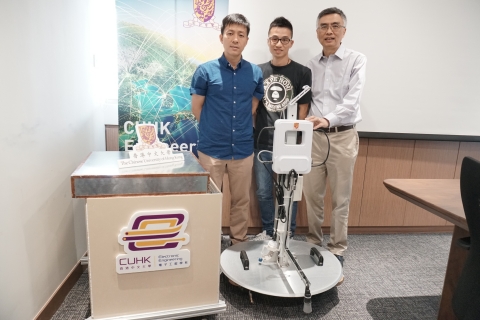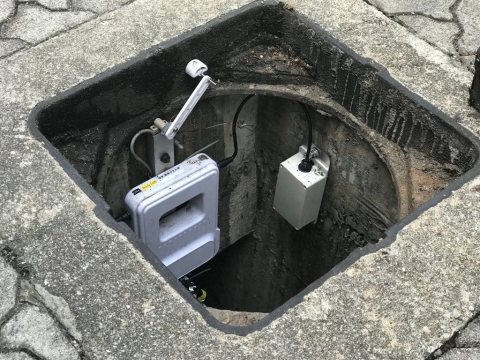The complexity of our urban drainage system and blockages in it may impose difficulty and danger on performing the onsite inspection and detection of hazardous gases such as sulphur dioxide and methane, and even increase the risk of flooding associated with adverse weather conditions. A certain concertation of methane may potentially cause explosion. Supported by the HKSAR Innovation and Technology Commission (ITC), a research team led by Prof. Wu Ke-li, Department of Electronic Engineering, has cooperated with the HKSAR Drainage Services Department (DSD), and Logistics and Supply Chain MultiTech R&D Centre (LSCM) to develop a wireless network for smart drainage system to provide real-time information on drainage performance, concentration of gases and water level. Underground environment has been a challenging environment for wireless communication but the team has successfully overcome this by creatively making use of the manhole cover as a part of its integrated sensor module and ubiquitous wireless network for detecting concentration of gases and water level. The improved wireless sensors have been installed and tested in hundred of manholes in Kowloon Bay district and proven feasible in safeguarding the drainage system of the city. Stormwater drains, sewers and manholes have always been part of the essential infrastructure of a modern city. Gases such as methane and sulphur dioxide will easily accumulate inside an enclosed underground condition. With the absence of an automatic gas detection device, excessive accumulation of the foresaid gases will be a hazard to frontline staff. Wireless signal transmission via manhole cover enabling real-time underground detection To address these urban challenges, the CUHK team has spent over two years designing a large-scale, real-time, smart and wireless drainage system which is the first of its kind in the world. Since last August, a hundred wireless underground devices have been installed in manholes of both stormwater drainage and sewerage systems in Kowloon Bay, forming a comprehensive system to monitor the water level and gas concentration of designated zones. Each underground device could be equipped with 5 different sensors to monitor the concentration of hydrogen sulfide (H2S), a colourless, corrosive gas with a “rotten egg” smell, and sulfur dioxide (SO2), a colourless but hazardous gas; and methane (CH4), a flammable gas; and the change of water level and to detect the opening status of the manhole cover. Through the wireless signal transmission and big data analysis, the smart drainage system enables frontline staff to take proper and timely action on gas emission, illegal wastewater discharge, and blockage. In this way, the prevention of explosion and flood risk and the early detection of environmental pollution will become more effective. Together with studying the change of water level and flow velocity, it will also be useful for building a smart city in the future. Prof. Wu Ke-li said, “One of the largest project challenges is to investigate how the wireless signals can penetrate a 14cm-thick iron manhole cover to reach a base station kilometers away and then transmit to the frontline staff through 4G network. The team has unleashed their creativity by transforming the manhole cover itself as part of integrated wireless network. The manhole cover used to be a conventional obstacle to signal transmission due to its thickness, but the team has changed its nature to an adaptable hardware for a low frequency communication system so that the data collected can be sent back to the base stations at roof top.” He continued, “Another challenge for the team is that the sensing devices wear out quickly because of high humidity and high concentration of corrosive gas inside the manholes. Taking this challenge into account, we have introduced the technic of using a micro gas sensor within a completely sealed environment so that both the durability and energy efficiency of the smart drainage system can be improved.” In the long run, the smart drainage system offers a creative and intelligent solution to city’s drainage management and promotes smart city development in Hong Kong with minimal installation costs and software requirements. Most importantly, the sensor styles and amounts can be built upon the needs of the users. CUHK Radio-frequency Radiation Research Laboratory Founded in 2006 and headed by Prof. Wu Ke-li, the Radio-frequency Radiation Research Laboratory of CUHK is the only facility of its kind on an academic campus in the world. It is an ISO/IEC accredited laboratory for mobile terminal performance test, passive antenna measurement and calibration and specific absorption rate measurement, and is equipped with the world’s most tested system for wireless communications. It has received the stringent ISO17025 Certificate of Accreditation. Over the past years, the laboratory has played an irreplaceable role in supporting the local wireless industry in product research and development, particularly the hardware devices of the project mentioned above. With strong interest and potential coming from a number of overseas and national institutes, Prof. Wu’s group is working on the patent application for the smart drainage system and hopes to offer an efficient solution to managing the city’s drainage system in different regions.
|
|



